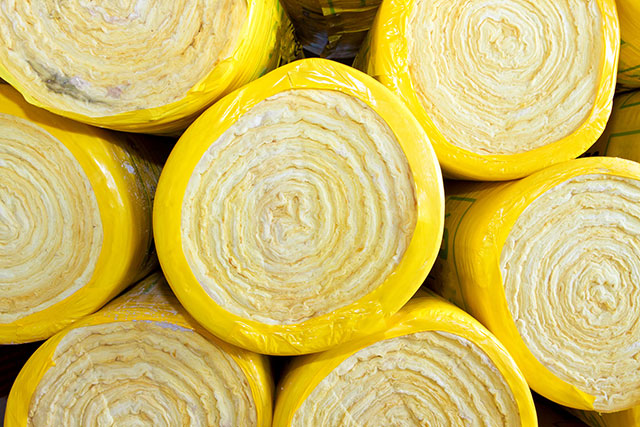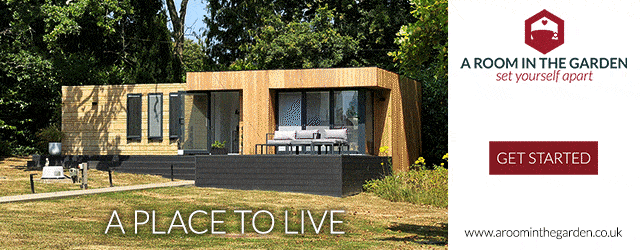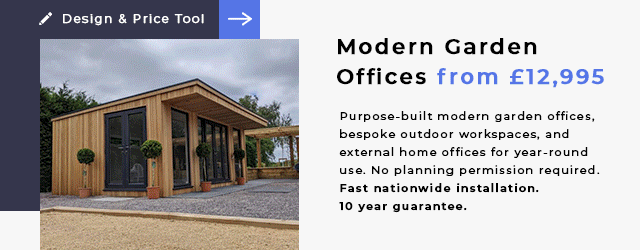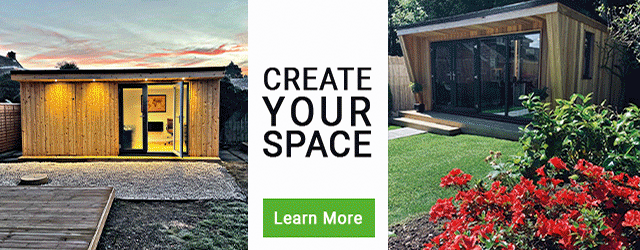We have written before how garden rooms are becoming a popular way of creating extra space, this is for many reasons – they have an adaptable layout, they are quick to build and more cost effective than other more traditional forms of building, but they have another significant benefit that we haven’t yet talked about – their green credentials.
Environmental issues should be important to us all, as the worlds natural resources are running low, and our decisions on how we live our life and the products we choose to use, all have an impact on the environment, luckily your choice to build a garden room works on several levels!
The construction industry as a whole is known for environmental waste, the materials commonly used such as cement use huge amounts of energy in their production, general builders are known to over order on materials so there are large amounts of waste on site, and traditional house building uses large amounts or embodied energy i.e. physical human energy to actually build the structures.
The garden room industry is largely united in the aim to turn these traditional problems of the construction industry on their head and create buildings that have strong environmental credentials both in production and in their long-term use.
GREEN BY DESIGN
Where the traditional construction industry (when we say traditional we mean brick built buildings) extensively use materials that have a high environmental impact in their production the garden room industry has chosen to dramatically reduce their use, for instance concrete production generates huge amounts of harmful C02 and in traditional building it is used extensively in foundations, obviously a good foundation is the basis of any good building and a garden room is no exception, but the industry has largely adopted the use of pad foundations which reduce the amount of concrete used by
as much as 90%, this is obviously a significant amount and is achieved by looking at the problem with fresh eyes.
Pad foundations are much quicker and easier to install than other slab type foundations so there is less embodied energy used in their installation, which in turn means less traveling to site. The green credentials of pad foundations continue in the long term too, if the building is ever moved, and some are relocated, a concrete pad can easily be removed from the site with little disruption to the landscape, and with some brands the pad can be reused so it has a long lifespan.
Moving up from the foundation 99% of garden rooms are built from wood, and on a quality garden room you can be sure this will have been sourced from FSC certified forests and in many cases the garden room supplier will be able to trace the origins of the timber they use via Chain Of Custody Certification.
Quick growing softwoods are widely used in the frame work of garden rooms and engineered wood products such as Orientated Strand Board (OSB) have been widely adopted, they are made from wood chippings which are bonded together to create a
CHOOSE A BUILDING SYSTEM THAT ENHANCES RATHER THAN HARMS
High levels of insulation is a major factor in the sustainability of garden room design
high strength board, the use of these structural boards means that the amount of regular timber can be reduced as these boards spread the load.
OSB is widely used as the facing for Structural Insulated Panels (SIP’s) these are sandwiches of structural board with a foam insulation in-between, these panels have revolutionized the garden room industry and are largely accountable for the flexibility of design, the speed of installation and the long term performance of the building.
Whether you choose a garden room that is built from traditional timber frame panels or modern SIP’s they will be predominately built off site in factory controlled conditions, this ensures that all materials arrive on site in optimal condition and the amount of time actually on site is a mere fraction of what it would be if built on site from scratch or if a comparable building was built using traditional techniques – this obviously reduces transportation significantly i.e. moving materials, tools and workforce to site, and because of the speed in which timber frames and SIP’s can be installed – two workmen can have a whole framework up in a day, the embodied energy is minimal.
There is minimal waste in garden room construction too, because most garden room suppliers design their buildings around the standard 1.2m (4ft) sizes of sheet material there is very little waste at the end of the build, this is obviously good for the environment because in most cases what offcuts there are can be recycled, and good for you as the customer because the cost of waste materials is not passed on to you in the price of the building!
A MAJOR FACTOR
Perhaps the most important element of an eco friendly garden room is its insulation, the more insulation the better performing the building will naturally be and in turn the less energy you will need to use. There are many types of insulation used in garden room design from quilts made from the spun fibres of recycled plastic bottles to rigid insulations made from chemical reactions, it is not for us to say which is the better choice, but we would urge you to choose a garden room with as much insulation as you can afford and ensure its specified in the floor, walls and roof – we say this because some log cabin style buildings sold as garden rooms don’t have insulation in the walls.
It’s a misconception that the thicker the insulation the better performing because 50mm of one type of insulation can perform better than 200mm of another! Your best way to compare is to look at the u-value this is measured in W/m2 and the lower the value the better performing. It should be mentioned that you should compare the u-value for the whole section i.e. wall, floor or roof as the other materials chosen such as the exterior cladding and the plasterboard internal lining and any air space will play a part in the final value.
GLAZING GOES HAND IN HAND WITH INSULATION
There is no point having a well-insulated garden room if you don’t compliment it with good quality doors and windows with double-glazing! It may seem obvious that your garden room will have double-glazing but we still have a few specifications sent to us with just single glazing listed, so check!
Whilst a double glazed unit is a good starting point, you can enhance the performance by choosing different types of glass and having the void between the panes filled with different gasses. Many garden room suppliers will offer options on their glazing, and popular options you will see are Pilkington ‘K’ and Planitherm and these are different coatings on the glass that create a low emission surface, this allows warm air to bounce back into the room rather than flow through the glass.
The other option you’ll see on glazing is the gas in-between the panes, the most popular being Argon an inert gas which has a lower thermal conductivity than air, so improves the performance of the glazing further.
Like insulation doors and windows are given a u-value and you should look for a combination that has the lowest u-value you can afford.
MOVING OUTSIDE
The choices of materials used for the exterior of the building also play their part in the sustainability of the building. Most garden rooms are timber clad and Western Red Cedar has largely been adopted because of its long lifespan and durability meaning it needs little if any chemical treatment to preserve the cladding and there is little embodied energy needed in the long term maintenance of the building.
Many ranges of garden room have a painted exterior finish and the suppliers of these buildings have researched the paints they use extensively and have chosen finishes that have low VOC (Volatile Organic Compound) levels which are harmful to the environment but have long lifespans meaning they don’t need repainting for many years, in addition these finishes don’t flake and cry out that they need repainting instead the finish biodegrades.
Roofs are another element where you can make a sustainable choice, garden room designers use the same materials that are used in house building so the tiles or membranes will last with little maintenance for many decades – great! But, if you want to make a green choice for your roof you might consider a living roof covering, these have become very popular as they replace vital ecosystems that the installation of the building itself may remove, for instance they provide habitats for insects which the birds eat etc. A living roof also looks fantastic and planned well can provide interest all year round, it also adds an extra layer of thermal insulation to the roof structure which will improve the overall performance of the building.
An important element, but one that’s not included in all specifications is rainwater collection. Its amazing how much water can run off the roof of a garden room, and it is important to either collect this water or move it away from the building. Unless rainwater is channelled away it can drip down walls and penetrate into the building so a rainwa- ter gutter system can preserve the building, meaning less maintenance and a longer life span. Its easy to attach a water butt to the downpipes and collect the rainwater for use on the garden.
Some people feel that guttering spoils the lines of the building, and a few suppliers have gone to great lengths to incorporate the guttering discreetly into the design, to the point its almost invisible!
BACK INSIDE
The interiors of garden rooms today are no different to the finish in a room in your house, so there are choices you can make in the decorative finish you choose, there are lots of eco friendly emulsions on the market today and some of the new chalk paint ranges which can be used on lots of different surfaces look interesting.
Your choice of heating and lighting will be your most significant sustainable design choices inside the garden room.
However well insulated a garden room is we have found you still need a heat source for the coldest days of the year. There are lots of options from under floor heating systems to air conditioning units and people have opinions about them all, our best piece of advice whatever type of heating you choose would be to have a system that has an easily controllable thermostat and ideally a timer so that you can control the temperature of the room and dictate the time of day that the heating is on. A timer can be very useful to program so the garden room is warm for when you go down there but is not churning out heat and energy when you’re not in the room. Some garden room suppliers offer remote control systems for the heating in the garden room that you can operate from the main house, by smart phone app or even by text.
Lighting is another choice you can make, the most energy efficient lighting is of course daylight and you can maximize this by having large windows on the south elevation of the building, glazing on the east and west elevations is also good. But, there are times of day when you will need artificial lighting and CFL (Compact Florescent Lights) and LED (Light Emitting Diodes) are your most energy efficient options. LED’s offer the longer life span with estimations that they last 20 years before replacement but some don’t consider them bright enough for interior lighting. We’re not lighting experts but this is certainly an area that you should research further.
So, as you can see a garden room is green by design, with build times as little as a week they don’t use a huge amount of manpower to build and because they are built like timber frame houses they will last for decades, and at the end of their usable life the structure can be recycled, add to this the benefits of no com- mute to work if you are planning to use the building as a office and it’s a win win situation.










